Corey Postiglione
Corey Postiglione (born 1942) is an American artist, art critic and educator. He is a member of the American Abstract Artists in New York,[1] and known for precise, often minimalist work that "both spans and explores the collective passage from modernism to postmodernism" in contemporary art practice and theory.[2] New Art Examiner co-founder Jane Allen, writing in 1976, described him as "an important influence on the development of contemporary Chicago abstraction."[3] In 2008, Chicago Tribuneart critic Alan G. Artner wrote "Postiglione has created a strong, consistent body of work that developed in cycles, now edging closer to representation, now moving further away, but remaining rigorous in approach to form as well as seductive in markmaking and color."[4]
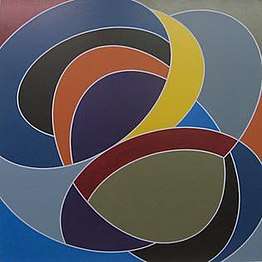
Corey Postiglione | |
|---|---|
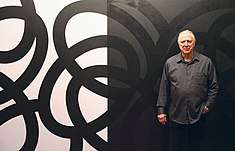 Corey Postiglione, Population 5 | |
| Born | 1942 Chicago, Illinois, United States |
| Nationality | American |
| Education | School of the Art Institute of Chicago, University of Illinois at Chicago |
| Known for | Painting & Drawing |
| Style | Abstraction, Minimalism |
| Movement | Postmodernism, Modernism |
| Spouse(s) | Kathie Shaw |
| Website | Corey Postiglione |
Life
Born into a working-class, Italian-American family on the north side of Chicago, Postiglione first developed an interest in art at Lane Tech High School. After serving in the U.S. Marine Corps and working a series of blue-collar jobs, he attended the University of Illinois at Chicago, graduating with a BFA in studio arts in 1971. He soon became active in a burgeoning art scene in Chicago, first exhibiting his work at Richard Gray Gallery, N.A.M.E., and Jan Cicero Gallery, and writing articles and reviews for the newly formed New Art Examiner. In 1990, he earned his MA in 20th Century Art History, Theory and Criticism from the School of the Art Institute of Chicago, studying under the postmodernist art critic Craig Owens, among others.[5]
Postiglione has exhibited internationally, at numerous colleges and universities, and at venues such as The Art Institute of Chicago,[6] Chicago Cultural Center, OK Harris Gallery, and the Hyde Park Art Center. He was honored with retrospective exhibitions at the Evanston Art Center in 2008 and the Koehnline Museum of Art, Des Plaines, Illinois in 2010. His artwork has been reviewed in publications including Artforum,[7] New Art Examiner,[8][9][10][11] the Chicago Tribune,[12] and the Chicago Daily News,[13] and is included in many private and public collections, including the Purdue University Galleries Permanent Collection and the Koehnline Museum of Art Permanent Collection.[14]
Postiglione is a founding member of the Chicago Art Critics Association[15] and has taught at several Chicago institutions, including Columbia College Chicago, where he was a member of the art department faculty for over 30 years.[16] He lives and works in Chicago with his wife, artist Kathie Shaw.[17]
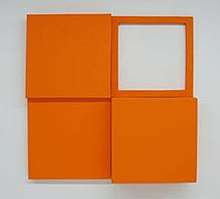
Work
In the early 1970s, Postiglione began creating minimalist drawings and paintings that were "striking for their purity of intent and realization"[3] and "spare simplicity."[18] Influenced by artists such as Frank Stella, Brice Marden, and Robert Mangold, these works explored the nature of paintings as objects, and often coupled severe geometric abstraction with a sensual celebration of gesture and materials.[19] However, Postiglione's sensibility ran counter to the narrative-driven, representational aesthetic of the Chicago Imagists and Hairy Who, which included artists such as Roger Brown and Ed Paschke, and whose work dominated the Chicago art scene from the late 1960s into the 1980s.[13][20][21]
For a time, Postiglione—described by critic Alice Thorson as "a prime mover in the geometric abstractionists' battle for recognition" in Chicago—and like-minded artists struggled to find a home beyond a handful of galleries supportive of their work, such as Jan Cicero and Roy Boyd.[22][23] In response, Postiglione and four other artists—Carol Diehl, Tony Giliberto, Mary Jo Marks, and Frank Pannier—banded together as the self-named "Artists Anonymous" to call attention to the plight of local abstractionists.[24][25][26]
Semiotic abstraction
Although Postiglione has maintained an abstract aesthetic to the present day, by 1978 he had begun to refashion 1960s hard-edged abstraction through a postmodern filter, creating metaphoric work with a visual connection to the life world that dissolved the opposition between abstraction and referentiality. His Scape and Passage works (1979-1986) drew comparisons to the paintings of Robert Moskowitz, reducing Chicago cityscapes and iconic structures like the Sears Tower to archetypal forms and shapes that paid "homage to the city's built environment (Daniel Burnham's grid plan, Frank Lloyd Wright's horizontal planes, Mies van der Rohe's vertical modules) and to the utopic vision its soaring edifices once embodied."[2][7]
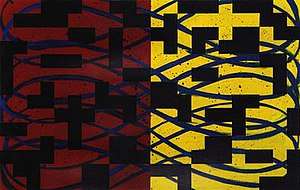
Explaining his conceptual development, Postiglione wrote, "My works hold to the universality of abstraction. But this is a semiotic abstraction; that is, I use different categories of abstract art to signify a metaphoric content."[27] He transformed the modernist grids of earlier work in the Labyrinth series (1990-1999), which was influenced by postmodern theorists Fredrick Jameson and Jean Baudrillard, and writer Jorge Luis Borges. In it, Postiglione probed personal themes of passage and sociocultural subjects such as decenteredness and progress within the formal motifs of the maze and labyrinth. Writing about works collectively entitled Utopian Dreams, critic Susan Snodgrass said, "the artist begins to question modernism's unwavering belief in modernity's (and art's) promise for social transformation."[2]
In his subsequent Exponential (1998-2009)[28] and Tango (2002-2015)[29] works, Postiglione expanded his vocabulary to include nodules, intertwined ovals and coiled pathways that reference constellations, molecular biology and viruses.[30] These works often "rely on elegant line and subtle coloration as bait to seduce the eye and draw the viewer close"[31] in order to contemplate the entanglement of pandemic, mortality and interconnection in an increasingly globalized world as well as the "movement, precision and seduction"[32] of the dance.
Postiglione has moved beyond canvas and paper in his five Population exhibitions (2004-2016),[33] producing site-specific paintings and interactive and collaborative installations that address demographic growth and the attendant issues of interdependence, scarcity and conflict.
In a recent interview, Postiglione described his approach in workmanlike terms: "I enjoy process and material and hands-on work. I have always said in reference to the conceptual aspects of the medium: when you make a painting, you are making at times a thousand critical decisions. It gives me great pleasure to make something and make it with precision and difficulty."[32] Postiglione continues to actively produce work out of the Ravenswood, Chicago studio he shares with his wife, Kathie Shaw. In 2018, he and Shaw were featured in a two-person exhibition at the Koehnline Museum of Art.[34]
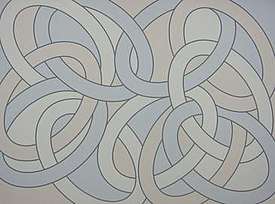
Art criticism
Postiglione worked as an art critic for more than two decades, making numerous contributions to the New Art Examiner, Artforum, Dialogue, and C Magazine. His written work includes features on Daniel Buren, Ed Paschke, Martin Puryear and Alexander Calder,[35] and exhibit reviews of Julia Fish, Michiko Itatani, Susan Michod, Dan Peterman, and Frank Stella, among many. He has also written catalogue essays for numerous artists, including Tim Anderson, Alexandra Domowska, James Juszczyk,[36] Terrence Karpowicz, Arthur Lerner,[37] and John Phillips.[38]
Postiglione has been an active curator of painting, drawing and sculpture exhibitions, in Chicago and nationally. These exhibitions have focused on single artists as well as on themes such as abstraction, the postmodern nude, travel, and postmodern landscape.[39][40] In 2018, he curated a retrospective at the Ukrainian Institute of Modern Art in Chicago for his one-time mentor at the University of Illinois in Chicago, abstract artist and educator Martin Hurtig.[41] Postiglione has also appeared publicly in a wide range of art forums, lectures and symposia.
Teaching
During a teaching career of over forty years, Postiglione has served as a mentor to a great many artists and art professionals. He first taught at the Evanston Art Center in 1971, where "he found himself leading a class of women at a time when the contemporary feminist movement was coming into its own and so were they."[42] Many of these students would go on to enjoy long art world careers, including artists Barbara Blades, Carol Diehl, Bonnie Hartenstein, Ellen Kamerling, Elizabeth Langer, Fern Shaffer and Annette Turow, and gallery owner Jan Cicero.[42][23][43] The Center's 75th-anniversary exhibit, "A Moment in Time: Women Artists and the EAC School, 1971-1978" (2004), commemorated that period by featuring work by the above-mentioned artists and six others that Postiglione taught during that time.[42]
Postiglione taught art at several higher learning institutions in Chicago in the 1970s, including the School of the Art Institute of Chicago, University of Illinois in Chicago and Illinois Institute of Technology. In 1979, he settled in at Columbia College Chicago's Department of Art and Design, where he would teach art history and criticism, graphic design, painting and studio practice, and create an "Art in Chicago" course. He was tenured in 1996, and in 2014, retired as Professor Emeritus.
References
- Wilkin, Karen and American Abstract Artists (2015). The Onward of Art: Eight Decades of American Abstract Artists. New York: American Abstract Artists. p. 75, 84. ISBN 978-0-9972072-0-0. Retrieved January 16, 2018.
- Snodgrass, Susan (2008). "Mapping New Geographies". Corey Postiglione: Discovery/Intimacy/Anxiety. Evanston, IL: Evanston Art Center.
- Allen, Jane. "Drawings by Corey Postiglione". New Art Examiner, March 1976, p. 14.
- Artner, Alan G. (February 8, 2008). "Abstract artist's twists and turns get due in retrospective". tribunedigital-chicagotribune. Retrieved January 14, 2018.
- Postiglione, Corey (1990). Drawn to Black: The Color Black in Contemporary Painting. Chicago: School of the Art Institute of Chicago.
- Art Institute of Chicago. Works on Paper: 77th Exhibition by Artists of Chicago and Vicinity, Chicago: Art Institute of Chicago. Retrieved July 10, 2018.
- Morrison, C.L. (March 31, 2015). "C.L. Morrison on Corey Postiglione". artforum.com. Retrieved January 14, 2018.
- Rooks, Michael. "Corey Postiglione, Columbia College Art Gallery". New Art Examiner March 1998, p. 52.
- Yood, James. "Chicago Draws". New Art Examiner, December 1986, p. 41.
- Ségard, Michel. "Corey Postiglione". New Art Examiner, June 1983, p. 16.
- Burnham, Jack. "Corey Postiglione, Mary Jo Marks, Virginia Ferrari". New Art Examiner, May 1977, p. 15.
- Artner, Alan (April 29, 1983). ""Corey Postiglione, Joel Bass". Chicago Tribune, Sect. 3, p. 13.
- Schulze, Franz (August 21, 1976). "The Chicago Movement: It's Moving Up". Chicago Daily News, Panorama, p. 11.
- Koehnline Museum of Art. Corey Postiglione (American, b. 1942), The Marriage of Reason and Logic, 1997, acrylic on canvas, 60 x 156 inches. Retrieved January 17, 2018.
- "Chicago Art Critics Association Web Site". Chicago Art Critics Association Web Site. Retrieved January 14, 2018.
- Westbrook, Modern. "Corey Postiglione (American)". Westbrook Modern. Retrieved January 14, 2018.
- Kathie Shaw official website . Retrieved February 12, 2018.
- Schulze, Franz (March 26, 1977). "The Gallery Market: It Can't Be Cornered". Chicago Daily News, p. 14-5.
- Argy. "Corey Postiglione". New Art Examiner, November 1985, p. 47.
- Artner, Alan (1976). "Cool Abstraction Takes the Ho-Hum Out of Summer Doldrums". Chicago Tribune, Sect. 6, p. 6-7.
- Schulze, Franz. "Art in Chicago: The Two Traditions," in Art in Chicago 1945-1995, Museum of Contemporary Art, ed. Lynne Warren. New York: Thames and Hudson, 1996, p. 13–31. Retrieved March 30, 2018.
- Thorson, Alice. "Chicago and Vicinity Show/1985". New Art Examiner, October 1985, p. 34.
- Isaacs, Deanna (December 26, 2002). “Abstract Angel”. Chicago Reader. Retrieved January 12, 2018.
- Segard, Michel. "The Other Tradition grows up: Chicago Abstractionists rise above a bitter legacy," New Art Examiner, March 1984, p. 8–9.
- Pannier, Frank. "A Painter Reviews Chicago, Part I" In The Essential New Art Examiner, Griffith, Terri and Kathryn Born, Janet Koplos, eds, Northern Illinois University Press, 2011, p. 15–8.
- Pannier, Frank. "A Painter Reviews Chicago, Part II," In The Essential New Art Examiner, Griffith, Terri and Kathryn Born, Janet Koplos, eds, Northern Illinois University Press, 2011, p. 19–23.
- Artist statement. Corey Postiglione: Retrospective of Paintings 1972-2010. Oakton Community College: Koehnline Museum of Art, p. 2.
- Postiglione, Corey. “Exponential Series,” Paintings, Corey Postiglione. Retrieved September 6, 2018.
- Postiglione, Corey. “The Tango Series,” Paintings, Corey Postiglione. Retrieved September 6, 2018.
- Postiglione, Corey. “Swarm Series,” Works on Paper, Corey Postiglione. Retrieved September 6, 2018.
- King Cap, Max (2010). "Fantastic Voyage: Corey Postiglione". Corey Postiglione: Retrospective of Paintings 1972-2010. Oakton Community College: Koehnline Museum of Art, p. 3.
- "Corey Postiglione – The Minimalist's Tango". The COMP Magazine. Retrieved January 14, 2018.
- "Corey Postiglione: Population 5". The Visualist. Retrieved January 14, 2018.
- Koehnline Museum of Art. Kindred Spirits: Recent Work by Kathie Shaw and Corey Postiglione, Exhibition catalogue, Oakton College: Koehnline Museum of Art, 2018.
- Postiglione, Corey. "Alexander Calder," Dictionary of American Biography, New York: Charles Scribner's Sons, Supplement 10 (1976-1980), 1994, p. 89-92.
- Postiglione, Corey (1990). "No-Space Space: The Border in James Juszczyk's Recent Work". in Haiku Geometry II: Paintings by James Juszczyk. Zurich: Viviane Ehrli Gallery. Retrieved January 16, 2018.
- Postiglione, Corey. "Images of Quiet Intensity," Walter Wickiser Gallery, catalogue, 1993.
- Postiglione, Corey (2004). "Curator's Foreword." John Phillips: Hot Mix 1979-2004. Chicago, IL: Columbia College. Retrieved January 16, 2018.
- Buchholz, Barbara B. (October 18, 1996). "Ordinary Objects Transformed". tribunedigital-chicagotribune. Retrieved January 14, 2018.
- Voeller, Megan (August 23, 2006). "Changing views". Creative Loafing: Tampa Bay. Retrieved January 14, 2018.
- Ukrainian Institute of Art. Martin Hurtig: A Retrospective Archived 2018-04-18 at the Wayback Machine, Chicago, 2018. Retrieved April 18, 2018.
- Isaacs, Deanna (February 26, 2004).“Postiglione's Women”. Chicago Reader. Retrieved January 11, 2018
- The Art Institute of Chicago, Artists Oral History Archive, Jan Cicero, Retrieved June 30, 2018.
External links
- Corey Postiglione official website
- The Art Institute of Chicago, Artists Oral History Archive: Corey Postiglione. Interview with Linda L. Kramer and Sandra Binion, 2012.
- Corey Postiglione artist page, Space Gallery
- Corey Postiglione artist page, Westbrook Modern Gallery